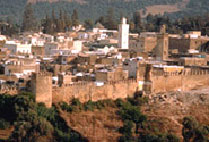Fez is a beautiful city surrounded by hills. It is made up of the walled medina, Fez el-Bali, Fez el-Jdid (1276) and the Ville Nouvelle, the new city that was built by the French. It is the third largest city in Morocco, after Casablanca and Rabat. It has a population of 946,815. Along with Marakesh, Meknes and Rabat, it is one of the four "imperial cities" of Morocco.
Fez reached its golden age in the 13th–14th centuries under the Marinids, when it replaced Marrakesh as the capital of the kingdom. The principal monuments in the medina, the residences and public buildings, date from this period.
Fez was founded by Idriss II in 809 on a site selected by his father, Idriss I. The city developed into a cultural center and a learning center with the growth of the Idrissi dynasty. It is the spiritual and cultural center of Morocco.
In Fez el- Bali there are two distinctly different districts. In 818, many hundred Moslem families fled the Spanish Inquisition in Andalusia and settled the right bank of Wadi Fez. Seven years later, 300 families from Qairouan established their homes on the opposite bank. The Andalusian Arabs brought with them art and the experience of the civilization of Muslim Spain. The refined building style is clear to see in the Andalusian quarter. The Andalus Mosque, built in 859, and the palaces have sculpted and carved woodwork, engraved bronze, musharrabiyas (carved lattice work screen used on windows) columns and sculpted plasterwork. Marble or onyx was used to pave the courtyards of public buildings.
Fez was the Arab capital to the Idrissis, and a center for religion and learning with the establishment of the Qarawiyyin Mosque and madrasa in 810. Muslim and Christian scholars from all regions came to study at its university, which was the best place for learning till the establishment in Cairo of al-Azhar in 972.
With the fall of the Idrissi dynasty in the mid-tenth century, a battle was fought by the Fatimids of Tunis and the Umayyads of Cordoba over the control of Fez. Each time the city changed hands, walls and fortifications were built.
Almurabitun who came from Berber tribes from the desert, took the opportunity to capture Fez when the Umayyad dynasty in the Andalus fell. By 1106 Almurabitun controlled the Andalus as well as Morocco.
Forty years later Fez was conquered by the Almuwahhidun in 1146.
In 1250 the Marinids captured Fez from the Almuwahhidun. Sultan Adbel Youssef Yacoub established Fez el-Jdid and made it the administrative center for the Marinids. Unlike their predecessors, the Marinids turned their attention to Morocco rather than the Andalus, and Fez reached its height in the 13th and 14th centuries.
In Fez el-Bali near the Bou’Inania madrasa, is the Dar-Batha museum. It houses the finest ceramic collection in Morocco, showing the art and techniques of Fez craftsmen. The famous "Fez blue" generally serves as a background, decorated with geometrical or stylized motifs.
The shrine and mausoleum of Moulay Idris II, built in the 14th century, are a pilgrimage destination and a site for civic ceremony
The 14th century Arab traveler Ibn Battuta is buried in Fez.
The Medina of Fez was inscribed a UNESCO World Heritage Site, 1981 based on the following UNESCO criteria:
• to exhibit an important interchange of human values, over a span of time or within a cultural area of the world, on developments in architecture or technology, monumental arts, town-planning or landscape design;
• to be an outstanding example of a traditional human settlement, land-use, or sea-use which is representative of a culture (or cultures), or human interaction with the environment especially when it has become vulnerable under the impact of irreversible change.


